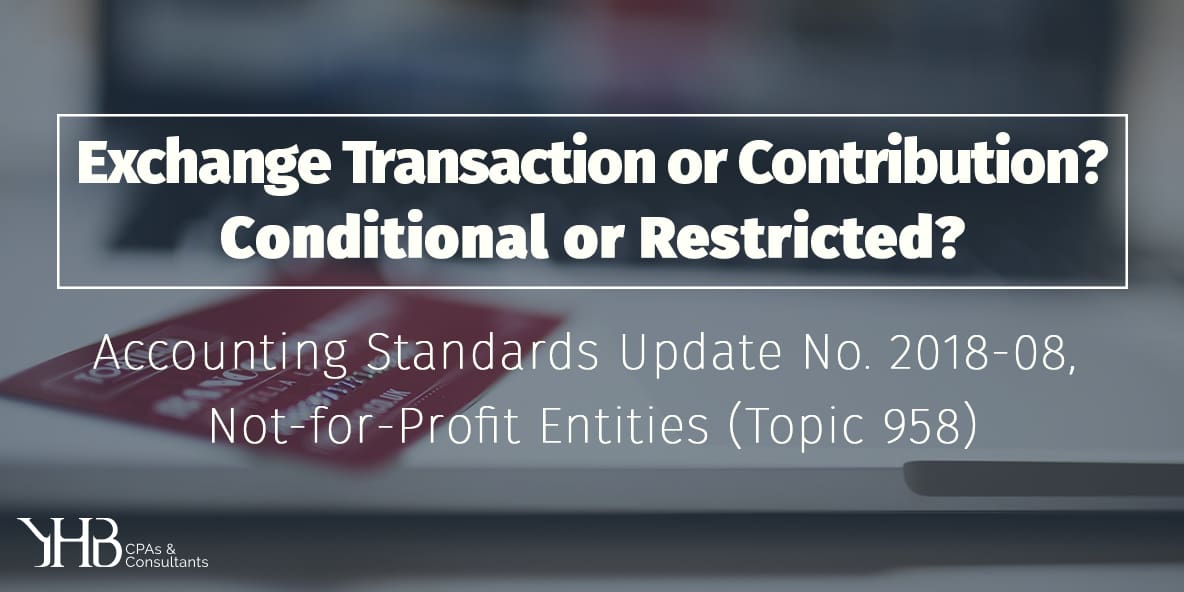In June 2018, the FASB issued Accounting Standards Update No. 2018-08, Not-for-Profit Entities (Topic 958), which clarifies the scope and the accounting guidance for contributions received and contributions made. Specifically, the update assists entities in determining whether a transaction should be accounted for as a contribution or an exchange transaction and, after that determination is made, which guidance should be followed.

A transaction is considered an exchange transaction if the resource provider receives commensurate value in return for any resources transferred. If a transaction is accounted for as an exchange transaction, other accounting guidance, for example, in Topic 606, Revenue from Contracts with Customers, should be followed.
A transaction is considered a contribution if the resource provider does not receive commensurate value in return for any resources transferred. If a transaction is accounted for as a contribution, guidance in Subtopic 958-605, should be followed.
Once a transaction has been deemed a contribution, an entity must determine whether a contribution is conditional, restricted or neither. The update assists also entities in determining this classification.
A contribution is conditional if two items exist: 1) a barrier (s) that must be overcome and 2) a right of return or release.
The standard further provides three examples that may indicate barriers; these include: 1) a measurable performance-related barrier or other measurable barrier, 2) limited discretion by the recipient on the conduct of an activity and 3) stipulations that are related to the purpose of the agreement. A measurable performance-related barrier would exist if the recipient of the resources had to meet any of the following: a) a specified level of service, b) an identified number of units of output or c) a specific outcome. A matching requirement would be an example of other measurable barrier. In regards to stipulations that relate to the purpose of the agreement, note that an administrative or trivial stipulation, such as a reporting requirement, is not necessarily indicative of a barrier.
If the contribution is not conditional, it will either be restricted or unrestricted. A restricted contribution can be more temporary in nature (ex. time restrictions placed on pledges receivable) or perpetual in nature (where the principal must be maintained and the earnings on the principal are either restricted or unrestricted). A contribution is restricted if it extends beyond the mission of the entity. Contributions received for a capital campaign would be an example of restricted contributions.
While the standard provides additional guidance, it is necessary to review the facts and circumstances, from both the perspective of the resource provider as well as the recipient of the funds, to determine the proper treatment of a transaction.
For contributions received, the standard is effective for public business entities for annual periods beginning after June 15, 2018. All other entities are required to implement the standard for annual periods beginning after December 15, 2018, for contributions received.
For contributions made, the standard is effective for public business entities for annual periods beginning after December 15, 2018. All other entities are required to implement the standard for annual periods beginning after December 15, 2019, for contributions made.
Early adoption of the standard is permitted.
READY TO TALK TO AN EXPERT? CONTACT OUR NOT-FOR-PROFIT & GOVERNMENTAL SERVICES TEAM.
About the Author
 Since joining YHB in 2012, Katrina’s career focus has been on nonprofit organizations such as private schools, colleges, foundations, religious organizations, museums, and other nonprofit entities. Her service to those organizations include audit and attest as well as tax services.
Since joining YHB in 2012, Katrina’s career focus has been on nonprofit organizations such as private schools, colleges, foundations, religious organizations, museums, and other nonprofit entities. Her service to those organizations include audit and attest as well as tax services.


